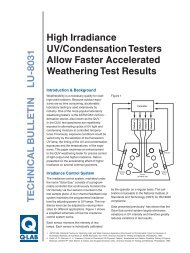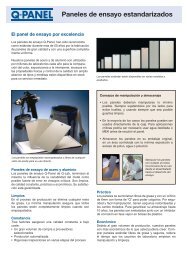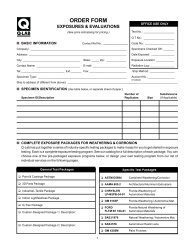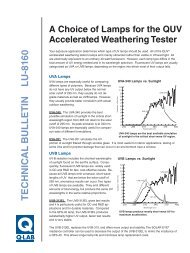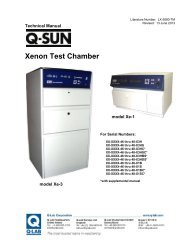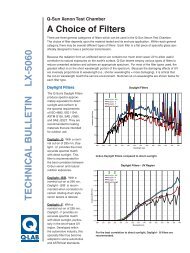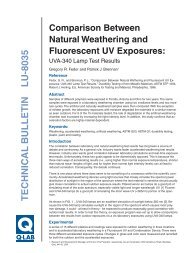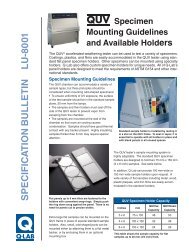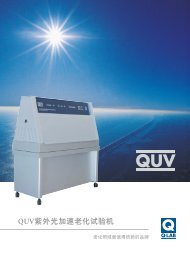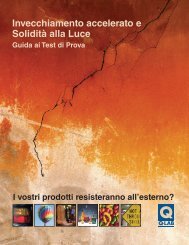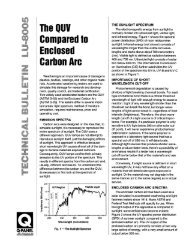Sunlight, Weathering, Light Stability - Q-Lab
Sunlight, Weathering, Light Stability - Q-Lab
Sunlight, Weathering, Light Stability - Q-Lab
Create successful ePaper yourself
Turn your PDF publications into a flip-book with our unique Google optimized e-Paper software.
For many manufacturers, it is crucial to formulate<br />
products that can withstand light exposure. Accelerated<br />
weathering testers are designed to simulate<br />
natural sunlight, and are widely used for research<br />
and development, quality control and material certification.<br />
These testers can provide fast, repeatable<br />
and reproducible results.<br />
Irradiance (W/m 2 /nm)<br />
1.0<br />
0.8<br />
0.6<br />
0.4<br />
TEST CONDITIONS<br />
date: 22 JUN 99<br />
location: Oberlin, OH<br />
direction: normal to sun<br />
IL1700 cal date: 17 MAY 99<br />
input optics: teflon 3/8" high<br />
wavelength increments: 5 nm<br />
2:00 PM<br />
1:00 PM<br />
3:00 PM<br />
12:00 PM<br />
11:00 PM<br />
4:00 PM<br />
10:00 AM<br />
5:00 PM<br />
9:00 AM<br />
6:00 PM<br />
8:00 AM<br />
7:00 PM<br />
2<br />
In order to quantify the wide variations in the UV<br />
content of sunlight, four categories of spectroradiometric<br />
measurements were taken. These<br />
include direct summer sunlight, winter sunlight,<br />
sunlight filtered though ordinary window glass and<br />
sunlight filtered through automotive glass.<br />
In order to quantify the spectra from the various<br />
lab testers, spectroradiometric measurements<br />
were made in various types of accelerated testers<br />
including QUV ® Accelerated <strong>Weathering</strong> Testers<br />
(i.e., fluorescent UV and condensation testers)<br />
and xenon arc chambers. In addition, spectra<br />
were calculated for the accelerated outdoor<br />
exposure device known as the Q-TRAC ® Natural<br />
<strong>Sunlight</strong> Concentrator. The various accelerated<br />
devices show a wide variety of spectra. These<br />
measurements suggest recommendations for the<br />
use of different testers or different light sources for<br />
different applications.<br />
The <strong>Sunlight</strong> Spectrum<br />
The electromagnetic energy from sunlight is normally<br />
divided into ultraviolet, visible light and infrared<br />
energy, as shown in Figure 1. Ultraviolet light<br />
consists of radiation below 400 nanometers (nm).<br />
Visible light is defined as radiation between 400<br />
and 760 nm. Infrared energy consists of wavelengths<br />
longer than the visible red wavelengths,<br />
and starts above about 760 nm.<br />
Variability of <strong>Sunlight</strong>. Because UV is easily<br />
filtered by air mass, cloud cover, pollution, etc., the<br />
amount and spectrum of natural UV exposure is<br />
extremely variable. <strong>Sunlight</strong> varies from moment<br />
to moment throughout the day. Figure 2 shows the<br />
spectral power distribution (SPD) of full spectrum<br />
sunlight measured at several times throughout the<br />
day (where & when).<br />
Irradiance (W/m 2 /nm)<br />
0.2<br />
0.0<br />
250 270 290 310 330 350 370 390<br />
Wavelength (nm)<br />
Figure 2- <strong>Sunlight</strong> Throughout the Day<br />
The SPD of sunlight also varies throughout the<br />
year. The greatest variability is in the UV region.<br />
Figure 3 shows a comparison of the UV regions<br />
of sunlight, measured in Cleveland, Ohio, USA at<br />
noon on:<br />
• The summer solstice (longest day of the year)<br />
• The winter solstice (shortest day of the year)<br />
• The spring equinox.<br />
These measurements are in agreement with data<br />
reported by other investigators. See ASTM G173<br />
for a useful reference spectrum.<br />
1.5<br />
1.0<br />
0.5<br />
March<br />
Equinox<br />
June<br />
December<br />
0.0<br />
250 270 290 310 330 350 370 390<br />
Wavelength (nm)<br />
Figure 3- Seasonal Variation of <strong>Sunlight</strong> UV<br />
7:00 AM<br />
8:00 PM<br />
(cloudy)<br />
Because the sun is lower in the sky during the<br />
winter months, it is filtered through a greater air<br />
mass (Figure 4). This introduces two important<br />
distinctions between summer and winter sunlight:<br />
changes in the intensity of the light and changes<br />
in the spectrum. Most importantly, the shorter,<br />
more damaging UV wavelengths are filtered out<br />
during the winter. For example, the intensity of<br />
UV at 320 nm is about 8 times greater in the<br />
summer than in the winter. In addition, the short<br />
wavelength solar cut-off shifts from about 295<br />
nm in summer to about 310 nm in winter months.<br />
Consequently, materials sensitive to UV below 310<br />
nm would degrade only slightly, if at all, during



